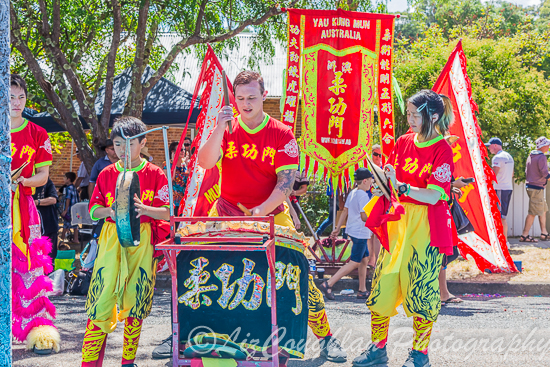These Chinese lions were a prominent feature of the festival.
Their tricks brought gasps of amazement from the people watching.
In Chinese culture, the lion is a symbol of stability and superiority. The purpose of the lion dance is to chase away ghosts and evil spirits.
The lions danced for the crowd…
…accompanied by a percussion band
The noise of the drums, gongs, and cymbals is intended to drive away the evil spirits, as the lions dance to their special rhythm.
The lions took to the air in daring performances, each trying to outdo the other
The crowd loved the yellow lion’s antics…
…especially his balancing act
This lion showed great coordination
As the show ended, people put money into red envelopes
and fed them to the lions for good luck.
Then along came the dragon parade
The Chinese Dragon is greatly respected in Chinese society, unlike its western counterpart that is generally greatly feared. The Chinese associate their dragons with positive traits like goodness, greatness, blessing, boldness, intelligence, abundance and prosperity.
…although this dragon looked pretty fierce to me!
The Nundle Go for
Gold Chinese Easter Festival was a very popular event...
There was a
carnival atmosphere, with stalls selling all manner of things,
and happy people
everywhere.
Lots of people tried their hand at gold panning during the festival.
Gold was the original reason why Chinese flocked to this area in Australia. From the 1850’s to the 1880’s thousands of people from all over joined the gold rush here. Most of them for the gold, but others came to set up stores and gardens to supply the diggers. Although many Chinese left as the gold ran out, choosing to try their luck elsewhere, some stayed and became a permanent part of Nundle’s history.
The notice says "Steam Engine. Built 1872 in Lincoln England, making it 130 years old.
Built by Ruston Hornsby Ltd." (Their maths is slightly out!)
Two lovely Chinese ladies
That was such a fun day, that we might think of ensuring we are in the area next Easter, so we can do this all over again! Thank you Jane, Suzi and families for an entertaining day out.
Elizabeth Coughlan









































